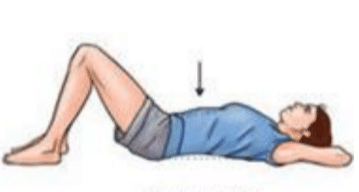Build Better Back
Daily stretching and light exercise can slow down the wear and tear, help you stay active, enjoy life, and avoid spine procedures and surgeries!
What makes up the back?
Your back is made up of your skeletal spine starting from the bottom of your skull down to your pelvis. The spine is one of the strongest parts of the body made up of bony vertebrae stacked on top of each other and held together by muscles, tendons, and ligaments all around. Between the bony vertebrae are discs giving it flexibility and added strength. The back is never in isolation, and it serves as the base of how we stay supine, prone, or upright. The body is all connected as one kinetic chain and your back is its most important base.

What is a kinetic chain?
The kinetic chain is a series of musculoskeletal and physiological forces that generate body movements that involve multiple body parts and locations that are all in concert. A person who does a single leg squat whose knee turns inward and wobbles as they go down indicates that they are in need of work in strengthening their quads, hip girdles and abdominal core muscles in order to maintain better balance.
What causes back pain?
Most severe back pain that come on suddenly is not usually due to a serious injury or disease. Most back pain usually will get better with time even without treatment or seeking help. Time is usually the most frustrating part because there is no way to predict a timeline and those who get back pain will eventually get it again. Addressing the back pain at its earliest stage is the most important step. The best thing you can do for back pain is to keep the back moving because immobilizing it would be detrimental. The spine is designed for constant movement so by keeping it on the move, the sooner it improves. Those who stay active are the ones who will get through back pain the best.

What kind of movements are best?
Any activity that keeps you active and avoids complete immobilization is the best start. For every 24 hours, you spend sedentary and bedbound, your body becomes deconditioned by at least 10 to 15%! Exercises should first focus on lower extremity flexibility then move on to strengthening of the hip girdle muscle groups and most importantly, core strengthening.
Walking is an exercise that may not mean much initially but it is an important step towards a healthier spine. Walking is a weight bearing exercise that allows for overall bone turnover and replenishment of the spine. At the very least, by walking, you allow for the mechanism of bone turnover and replenishment leading to overall health and homeostasis of the spine.
Why stretch and strengthen?

Core strengthening does not only mean getting ripped abdominal muscles. The core comprises all the muscles that wrap around the abdominal region in the front, sides and back along with the associated muscles of the hip. Look at the illustration below. These muscles are like the critical scaffold that supports the spine! When strengthened well, the core muscles contribute to a better aligned and stable spine. The next time you catch yourself slouched and you will, you can bet it is because of a weak core. Daily stretching and exercises will slow down the normal wear and tear process of the spine and help you stay active, enjoy the things you do as long as possible, and avoid procedures or surgeries!
Imagine very tight hamstring muscles pulling down on the pelvis and as one bends forward, the opposing forces pull on the pelvis, something will have to give. Stretching every day and incorporating it into the daily exercises makes for a healthy and better back.

Try these exercises:
Neck/Upper Back exercises
Chin Tuck: Lace your fingertips on your chin and gently push your head straight back as if you are trying to make a double chin. Keep looking forward as your head moves back. Hold 5 seconds and repeat 5 times.
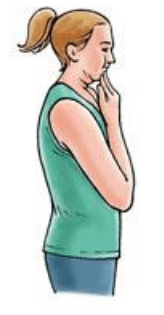
Chin Tuck
Scalene Stretch: This stretches the neck muscles that attach to your ribs. Sitting in an upright position, clasp both hands behind your back, lower your left shoulder, and tilt your head toward the right. Hold this position for 15 to 30 seconds and then come back to the starting position. Lower your right shoulder and tilt your head toward the left until you feel a stretch. Hold for 15 to 30 seconds. Repeat 3 times on each side.
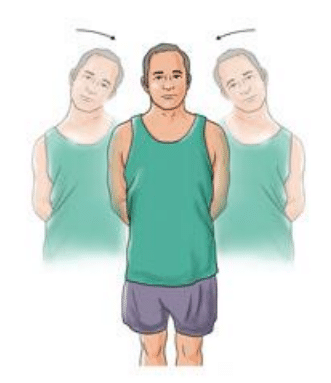
Scalene Stretch
Scapular Stretch: While sitting or standing with your arms by your sides, squeeze your shoulder blades together and hold for 5 seconds. Do 3 sets of 10.

Scapluar Squeeze
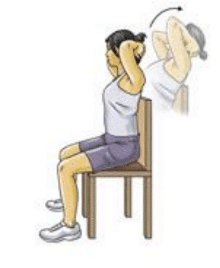
Thoracic extension
Rowing exercise: Tie a piece of elastic tubing around an immovable object and grasp the ends in each hand. Keep your forearms vertical and your elbows at shoulder level and bent to 90 degrees. Pull backward on the band and squeeze your shoulder blades together. Repeat 10 times. Do 3 sets.
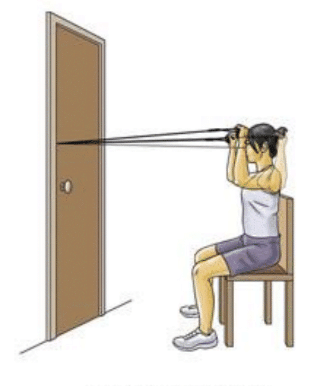
Rowing exercise
Arm slide on wall: Stand with your back against a wall and your elbows and wrists against the wall. Slowly slide your arms upward as high as you can while keeping your elbows and wrists against the wall. Do 3 sets of 10.
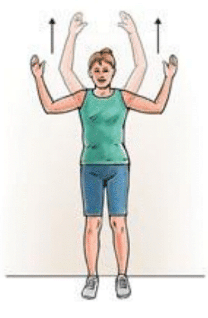
Arm slide on wall
Low Back exercises
Gluteal Stretch: Lying on your back with both knees bent, rest the ankle of one leg over the knee of your other leg. Grasp the thigh of the bottom leg and pull that knee toward your chest. You will feel a stretch along the buttocks and possibly along the outside of your hip on the top leg. Hold this for 15 to 30 seconds. Repeat 3x.
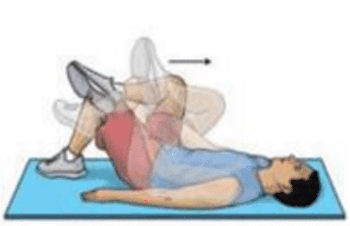
Gluteal Stretch
Standing Hamstring Stretch: Place the heel of one leg on a stool about 15 inches high. Keep the knee straight. Lean forward, bending at the hips until you feel a mild stretch in the back of your thigh. Make sure you do not roll your shoulders and bend at the waist when doing this or you will stretch your lower back instead of your leg. Hold the stretch for 15 to 30 seconds. Repeat 3x.
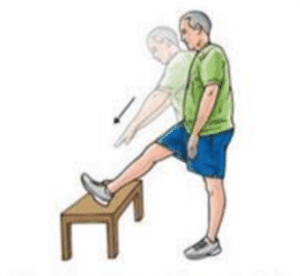
Standing Hamstring Stretch
Extension Exercise: Lie face down on the floor for 5 minutes. If this hurts too much, lie face down with a pillow under your stomach. This should relieve your leg or back pain. When you can lie on your stomach for 5 minutes without a pillow, then you can continue with the rest of this exercise.

Extension Exercise
After lying on your stomach for 5 minutes, prop yourself up on your elbows for another 5 minutes. Lie flat again for 1 minute, then press down on your hands and extend your elbows while keeping your hips flat on the floor. Hold for 1 second and lower yourself to the floor. Repeat 10 times. Do 4 sets. Rest for 2 minutes between sets. You should have no pain in your legs when you do this, but it is normal to feel pain in your lower back. Do this several times a day.
Quadruped arm/leg raise: Get down on your hands and knees. Tighten your abdominal muscles to stiffen your spine. While keeping your abdominals tight, raise one arm and the opposite leg away from you. Hold this position for 5 seconds. Lower your arm and leg slowly and alternate sides. Do this 10 times on each side.
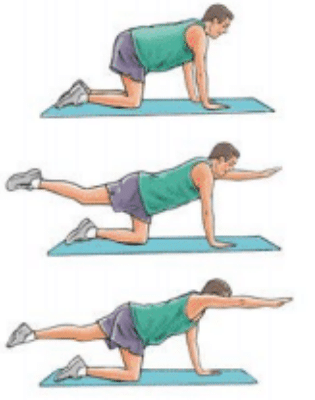
Quadruped arm/leg raise
Side planks: Lie on your side with your legs, hips, and shoulders in a straight line. Prop yourself up onto your forearm so your elbow is directly under your shoulder. Lift your hips off the floor and balance on your forearm and the outside of your foot. Try to hold this position for 15 seconds, then slowly lower your hip to the ground. Switch sides and repeat. Work up to holding for 1 minute or longer. This exercise can be made easier by starting with your knees and hips flexed to 45 degree angles
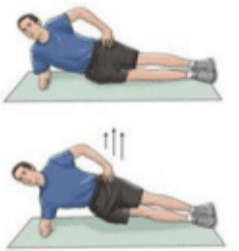
Side planks
Pelvic Tilt: Lie on your back with your knees bent and your feet flat on the floor. Tighten your abdominal muscles and push your lower back into the floor. Hold this position for 5 seconds, then relax. Do 3 sets of 10.
